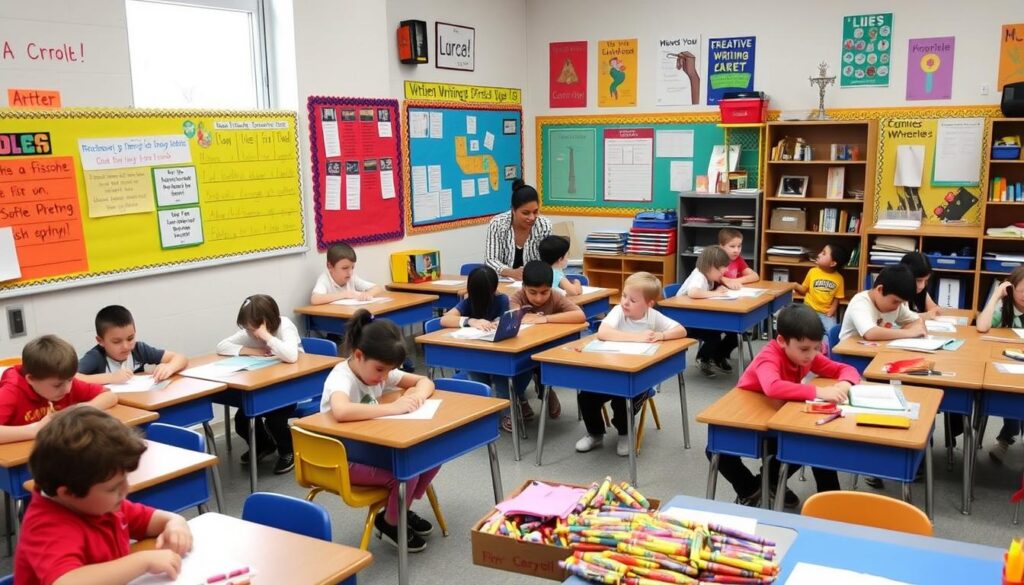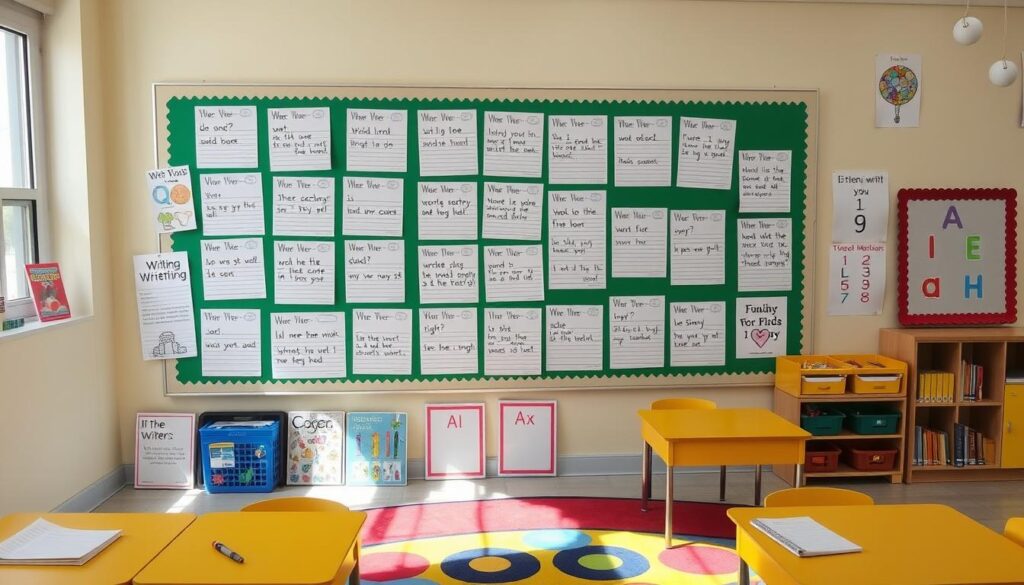Teaching writing to first graders is essential to their development. It allows them to share their ideas and creativity.To start, introduce the basics like alphabet letters and simple sentences. A supportive and fun learning space is crucial for their writing journey.
It’s important to give students chances to write and offer feedback. This makes writing fun and helps them build a strong writing foundation. It prepares them for future school success.

By focusing on the basics and creating a supportive space, teachers help students grow. This confidence in writing is vital for their future. It shows how important teaching writing is in first grade.
Key Takeaways
- Introduce the basics of writing, such as alphabet letters and sounds, when teaching writing to first graders.
- Create a supportive and engaging learning environment to encourage students to develop their writing skills.
- Provide opportunities for students to practice writing and offer feedback and guidance.
- Make writing a fun and enjoyable experience to help students develop a strong foundation in writing.
- Focus on the fundamentals of writing to help students become confident writers.
- Teaching writing in first grade is essential for students’ future academic success.
Understanding First Grade Writing Fundamentals
Teaching writing to first graders is all about knowing their growth stages and basic writing skills. At this age, kids start to write and express themselves. It’s key to create a space where they can be creative and share their thoughts. Primary school writing techniques should help them learn to write their name, trace letters, and craft simple sentences.
For writing strategies for 1st grade, teachers should use pictures, give personal lessons, and mix writing into everyday tasks. This method lets students learn at their own speed and enjoy the process. Key parts of first grade writing include:
- Improving fine motor skills through drawing and tracing
- Learning to write letters and words
- Creating simple sentences and short stories
By grasping these basics and applying primary school writing techniques, teachers can lay a solid writing foundation for their students. This prepares them for success in later years.
| Developmental Milestone | Description |
|---|---|
| Scribbling | Random marks on paper, often accompanied by verbal descriptions |
| Letter Formation | Writing letters, either correctly or incorrectly, to form words |
| Simple Sentences | Writing short sentences, often with basic punctuation and capitalization |
Essential Strategies for Teaching Writing to First Graders
Teaching writing to first graders needs a mix of strategies. These should match different learning styles and abilities. The best methods include using visual aids, giving one-on-one lessons, and making writing part of daily life. This helps students grow their writing skills and feel more confident.
Some great ways to teach writing to first graders include:
- Using games, songs, and rhymes to make writing fun and engaging
- Providing chances for students to write and giving them feedback and guidance
- Adding writing to daily tasks, like writing stories or journal entries
By using these strategies, teachers can lay a solid foundation in writing for their students. This is key for their success in school and beyond. Teaching writing is a crucial part of first-grade learning. With these methods, teachers can help students become confident and skilled writers.

Studies show that making writing fun and interactive is the best way to teach first graders. By adding games, songs, and rhymes to writing lessons, teachers can spark a love for writing. This approach also boosts students’ confidence and motivation, which are vital for their future success.
| Strategy | Description |
|---|---|
| Visual Aids | Using pictures and diagrams to help students understand writing concepts |
| One-on-One Instruction | Providing individualized instruction and feedback to students |
| Writing Games | Using games and activities to make writing a fun and engaging experience |
Developing Strong Handwriting Skills in First Grade
Teaching writing skills to first graders is key for their success. Good handwriting habits start with proper pencil grip and letter formation. Studies show that regular handwriting practice boosts performance in reading and math.
To help first graders improve their handwriting, teachers can offer practice opportunities. They should also give feedback and include activities that enhance fine motor skills. Some effective methods include:
- Using worksheets and tracing letters to practice letter formation
- Encouraging students to write letters in the air with their fingers
- Providing fine motor skill activities, such as playdough and puzzles, to improve hand-eye coordination and dexterity
Strong handwriting skills in first grade lay the groundwork for future academic success.
It’s important to make teaching writing fun and engaging. Using games and hands-on exercises can make learning enjoyable. This approach helps students develop a solid writing foundation and prepares them for success in all subjects.
| Activity | Benefits |
|---|---|
| Playdough | Improves fine motor skills and hand-eye coordination |
| Puzzles | Enhances problem-solving skills and hand-eye coordination |
| Coloring | Develops fine motor skills and hand-eye coordination |
Setting Realistic Writing Expectations
Teaching writing to first graders means setting achievable goals. They should write their name, simple sentences, and short stories. They also need to know basic punctuation and capitalization. Teachers can help by giving students chances to write and offering feedback.
Creating a supportive writing space is key. It lets students express themselves through writing. This helps them build a strong writing foundation for the future.
- Writing their name and simple sentences
- Using basic punctuation and capitalization
- Creating short stories and paragraphs
Every child learns at their own speed. Some might need more time to get better at writing. Teachers can help by setting realistic goals and using good strategies.

By following these tips, teachers can make their students confident writers. This boosts their academic performance and future success.
| Writing Skill | Expected Level |
|---|---|
| Writing name and simple sentences | Legible and accurate |
| Using basic punctuation and capitalization | Consistent and correct |
| Creating short stories and paragraphs | Coherent and engaging |
Conclusion: Building Confident First Grade Writers
Teaching writing in first grade is key for a student’s education. It’s important to know how first-grade writing develops. Teachers should use the right strategies and set achievable goals.
The best way to teaching writing to first graders is to mix different teaching methods. This way, students learn in their own way and get lots of practice and feedback.
First-grade students can learn to write well with the right teaching. They’ll get better at handwriting and understand how to write. This will help them express their thoughts clearly.
As they grow, these writing skills will help them even more. They’ll be ready for harder writing tasks.
By focusing on first-grade writing, teachers help students become better communicators. They’ll think critically and keep learning for their whole lives. This prepares them for success in school and beyond.
FAQ
What are the first steps to teach writing to first graders?
Start by teaching the basics of writing, like alphabet letters and sounds. Also, introduce simple sentences. Make the learning environment supportive and fun to help students grow their writing skills.
What should first grade writing look like?
First grade writing should mix scribbles, letters, and simple sentences. It’s all about being creative and expressing oneself. Kids should move from scribbling to writing letters and words, and then short sentences.
What are the best teaching strategies for Grade 1 writing?
Use visual aids and give one-on-one instruction. Make writing a part of daily activities. Games, songs, and rhymes can make it fun and engaging for students.
How can I improve first grader handwriting?
Give students chances to practice writing and offer feedback. Include fine motor skill activities in lessons. Teaching the right pencil grip and letter formation can also help.
How much should a 1st grader be able to write?
First graders should write their name, simple sentences, and short stories. They should also know basic punctuation and capitalization. But, remember, every child learns at their own pace.
